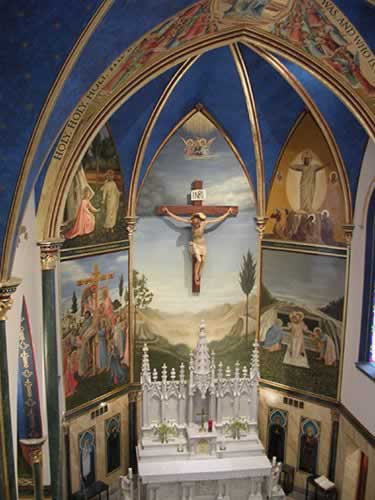Via Darwin Catholic is the site of a company that does hand painted murals for churches and other restoration. The before and after photo’s are the way they should be. That is more beautiful when renovated. Their about page says this.
The traditional vocation of sacred art
is to evoke faith and adoration by making
the invisible, visible, and lifting our hearts and minds
to the transcendent mystery of God.
Take a look at their pages on Hand-Panted Murals, Liturgical Design, and Statuary and have a feast for your eyes.

In a related story Gerald tells of a close call for a cathedral which was almost as he calls it "voskoized."

4 comments
I’ve been in that church, it’s not too far from my school. It’s even more beautiful inside than in the pictures — much better than the orange shag carpet from the “before” pictures!
I am greatly saddened that such things are still being perpetrated in these modern times.
Don’t they know that churches should now are gathering places for the community. Don’t they know that churches are no longer objects of devotion by itself nor is are they temples to honor the deity.
These art pieces betray the “Spirit of Vatican II” since they fail to promote social, racial and gender justice. And since the art is representational as opposed to abstract they reinforce old sterotypes of who Jesus is. People must be allowed to interrupt Jesus anyway they want. Finally, it is outmoded to show Jesus cruxified since we must only remember the risen Jesus and not the gruesomness of his death. Haven’t we gone beyond that?
Also those Pre-Vatican II altars reinforce the outmoded models of the division between the priest and worshippers. Vatican II mandates active participation by the people. The community is not engaged by such altars.
Come on people, are you so old fashioned as to still want churches like those. As people of the Post-Vatican II era, let’s get beyond mere devotion, sentiment and emotion.
Good one, Richard! For a minute there, I thought you were serious.
Actually Richard, if you were able to see the art up close you would see that though it is Fra Angelico the faces fo the people are multi-cultural.
For instance, to the left of the altar the Crowining of Mary is depicted and their are asian and other non-Europeans depicted, on the right of the altar the Visit of the Magi is depicted and there is a Philippino, an African, and at least a few other non-Europeans.
The parish was emphatic that it wanted the multi-cultural nature of its parishoners represented. Many of the people that are depicted are modeled directly after parishioners and priests, for example, the missionary priest from Africa is one of the Magi, and the Philippino in the same scene is one of the Brothers of St. John who is a native of Cebu, Philippines.
Further, the saints and blesseds depicted on either side of the tabernacle are a broad representation, they are from left to right, Mother Teresa, Faustina Kowalska, Jose Escrivia, and Padre Pio.
Take a deep breath Richard, all is not lost.
The beauty and glory of this sanctuary at St. Mark’s is not to be missed if you’re ever in Peoria, IL.